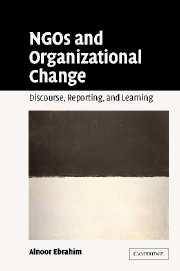Book contents
- Frontmatter
- Contents
- List of figures
- List of tables
- Acknowledgments
- List of abbreviations
- Introduction
- 1 The making of NGOs: the relevance of Foucault and Bourdieu
- 2 The NGOs and their global networks
- 3 NGO behavior and development discourse
- 4 Interdependence and power: tensions over money and reputation
- 5 Information struggles: the role of information in the reproduction of NGO-funder relationships
- 6 Learning in NGOs
- 7 Challenges ahead: NGO-funder relations in a global future
- Notes
- References
- Index
1 - The making of NGOs: the relevance of Foucault and Bourdieu
Published online by Cambridge University Press: 22 September 2009
- Frontmatter
- Contents
- List of figures
- List of tables
- Acknowledgments
- List of abbreviations
- Introduction
- 1 The making of NGOs: the relevance of Foucault and Bourdieu
- 2 The NGOs and their global networks
- 3 NGO behavior and development discourse
- 4 Interdependence and power: tensions over money and reputation
- 5 Information struggles: the role of information in the reproduction of NGO-funder relationships
- 6 Learning in NGOs
- 7 Challenges ahead: NGO-funder relations in a global future
- Notes
- References
- Index
Summary
In 1994, the European Commission (EC) granted over US $14 million to fund rural development and environment activities in western India. The grant, entitled “Community Management of Natural Resources,” was to jointly support two of the country's largest and most reputed non-governmental organizations (NGOs) – the Aga Khan Rural Support Programme, India (AKRSP (I)) and the Navinchandra Mafatlal Sadguru Water and Development Foundation (Sadguru). The EC funds, to be disbursed over the course of eight years, signaled a precedent for development aid: it was the European Community's largest and first bilateral allocation of funds directly to the non-governmental sector in India.
The proposal which was the basis for the EC grant, began by outlining the social and physical conditions of rural western India:
Social development is failing in large areas of rural India because of environmental degradation. Population pressure, poverty and competition are undermining the natural resource base on which rural communities depend. Most rural families still rely on rainfed cultivation of unimproved crops, livestock grazing on degraded commons, and foraging for fuelwood in un-managed forests. As a direct consequence, large numbers of people continue to live below the official poverty line. Much of rural Gujarat and the neighbouring states of Rajasthan, Madhya Pradesh and Maharastra fit this pattern.
(Aga Khan Foundation 1993:1)This early passage in the proposal points to a central assumption of the EC's “Community Management of Natural Resources” (CMNR) project.
- Type
- Chapter
- Information
- NGOs and Organizational ChangeDiscourse, Reporting, and Learning, pp. 7 - 20Publisher: Cambridge University PressPrint publication year: 2003
- 1
- Cited by

